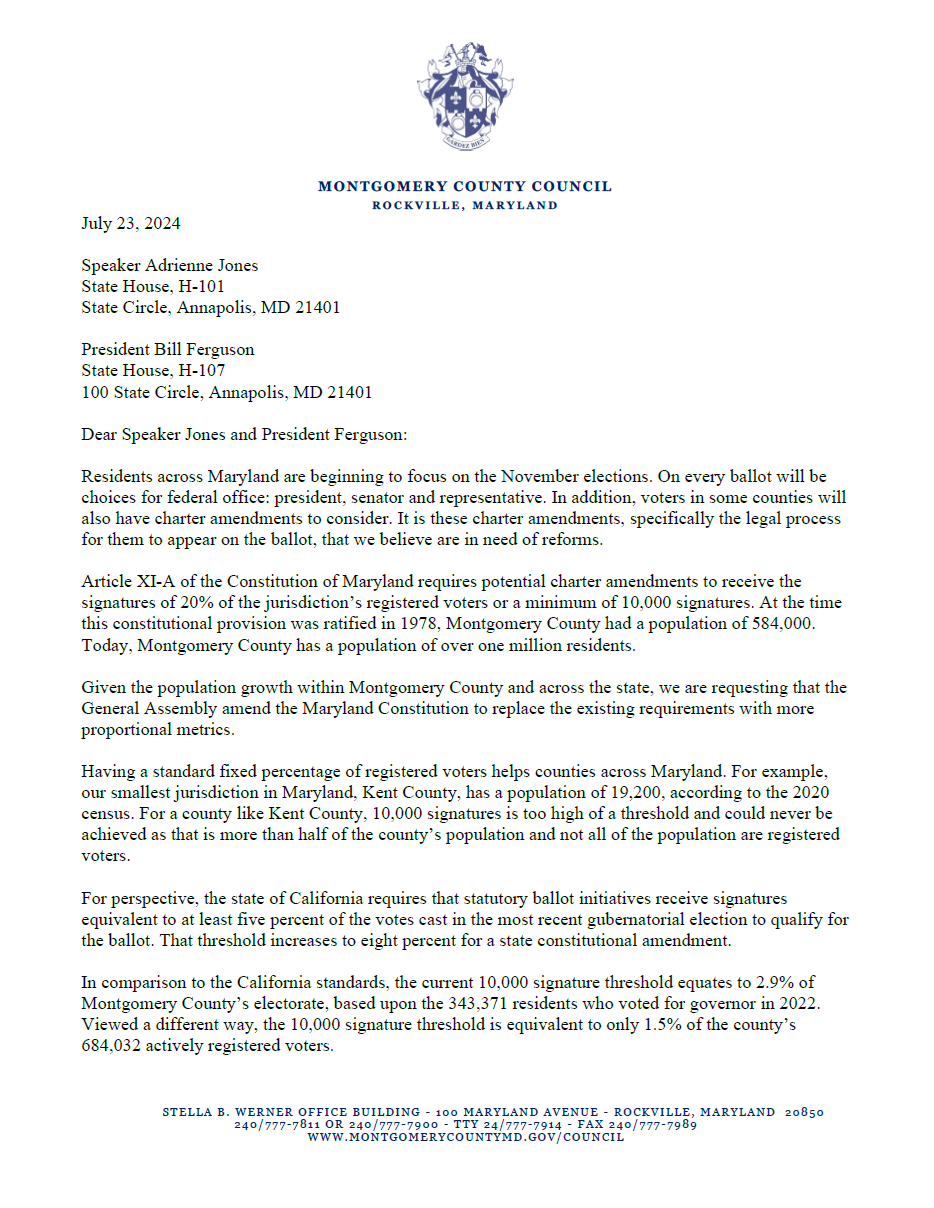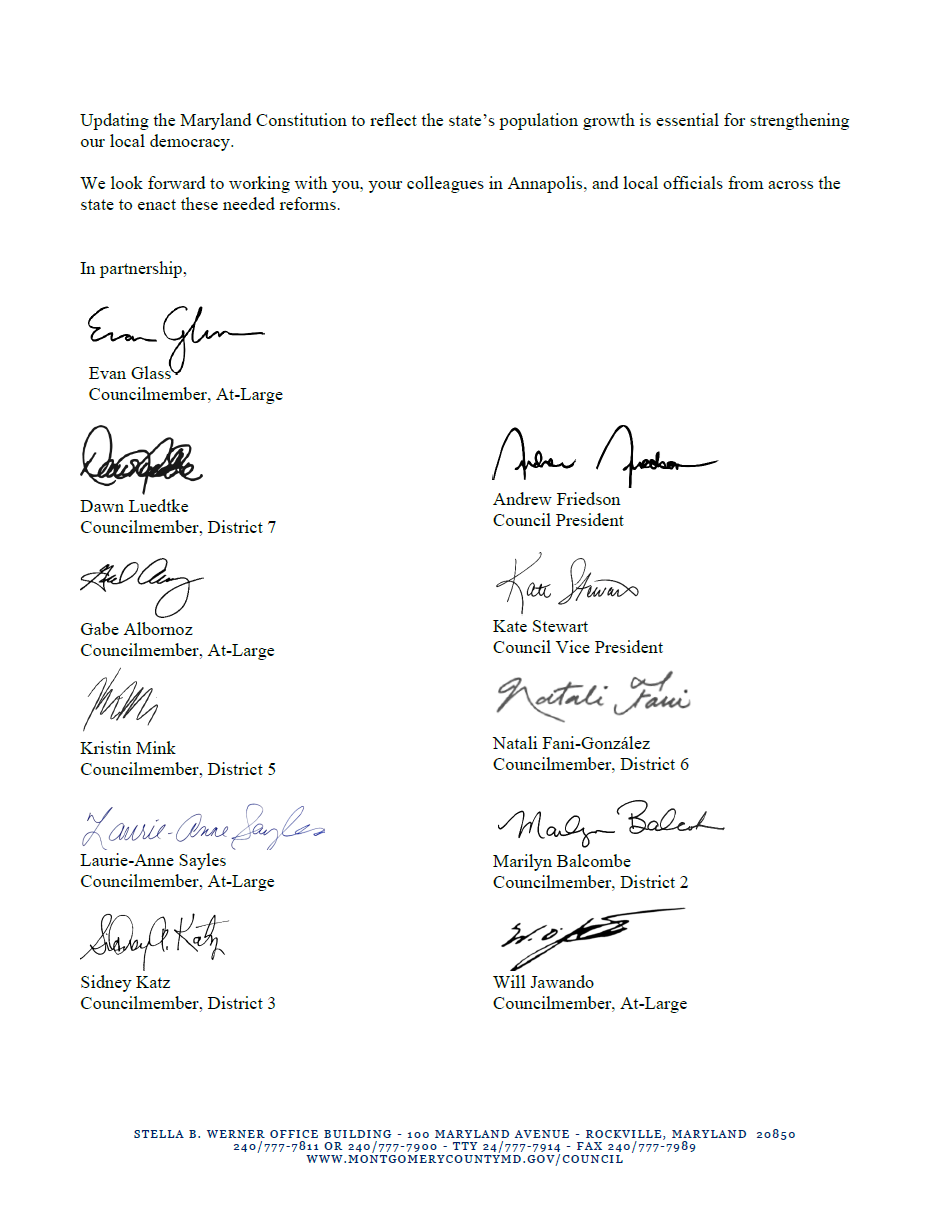By Adam Pagnucco.
Montgomery County’s charter was approved by voters in 1968. It is effectively the county’s constitution, and along with state law, sets the parameters by which the county government conducts its business. Article XI-A, Section 5 of Maryland’s Constitution lays out this process for charter amendments:
Amendments to any charter adopted by the City of Baltimore or by any County of this State under the provisions of this Article may be proposed by a resolution of the Mayor of Baltimore and the City Council of the City of Baltimore, or the Council of the County, or by a petition signed by not less than 20% of the registered voters of the City or County, provided, however, that in any case 10,000 signatures shall be sufficient to complete a petition.
Charter amendments have appeared on Montgomery County ballots many times. Some are mundane while others are momentous. Recent ones that have been generated through voter signatures rather than council action include a unanimous council override requirement for property tax increases (passed in 2008), term limits for county executive and county council (passed in 2016), abolition of at-large council seats (failed in 2020) and elimination of overrides for property tax increases (failed in 2020). Another term limits amendment for county executive will be on the ballot this year.
County leaders often must strategize on how to handle these voter-initiated charter amendments. One idea that has gained purchase at the county council is to beseech the state to make them harder to qualify for the ballot. Every member of the council has signed a letter to the presiding officers of the General Assembly asking them to pass a constitutional amendment to raise the signature requirement for charter amendments. Let’s note that if voter-initiated amendments are eliminated, there will be only one way to place charter amendments on the ballot: through a vote of the council itself.
As you might imagine, I have an opinion about this. But for now, let’s consider the position of the council. Its letter to the General Assembly is reprinted below.
*****
July 23, 2024
Speaker Adrienne Jones
State House, H-101
State Circle, Annapolis, MD 21401
President Bill Ferguson
State House, H-107
100 State Circle, Annapolis, MD 21401
Dear Speaker Jones and President Ferguson:
Residents across Maryland are beginning to focus on the November elections. On every ballot will be choices for federal office: president, senator and representative. In addition, voters in some counties will also have charter amendments to consider. It is these charter amendments, specifically the legal process for them to appear on the ballot, that we believe are in need of reforms.
Article XI-A of the Constitution of Maryland requires potential charter amendments to receive the signatures of 20% of the jurisdiction’s registered voters or a minimum of 10,000 signatures. At the time this constitutional provision was ratified in 1978, Montgomery County had a population of 584,000. Today, Montgomery County has a population of over one million residents.
Given the population growth within Montgomery County and across the state, we are requesting that the General Assembly amend the Maryland Constitution to replace the existing requirements with more proportional metrics.
Having a standard fixed percentage of registered voters helps counties across Maryland. For example, our smallest jurisdiction in Maryland, Kent County, has a population of 19,200, according to the 2020 census. For a county like Kent County, 10,000 signatures is too high of a threshold and could never be achieved as that is more than half of the county’s population and not all of the population are registered voters.
For perspective, the state of California requires that statutory ballot initiatives receive signatures equivalent to at least five percent of the votes cast in the most recent gubernatorial election to qualify for the ballot. That threshold increases to eight percent for a state constitutional amendment.
In comparison to the California standards, the current 10,000 signature threshold equates to 2.9% of Montgomery County’s electorate, based upon the 343,371 residents who voted for governor in 2022. Viewed a different way, the 10,000 signature threshold is equivalent to only 1.5% of the county’s 684,032 actively registered voters.
Updating the Maryland Constitution to reflect the state’s population growth is essential for strengthening our local democracy.
We look forward to working with you, your colleagues in Annapolis, and local officials from across the state to enact these needed reforms.
In partnership,
Evan Glass
Councilmember, At-Large
Dawn Luedtke
Councilmember, District 7
Gabe Albornoz
Councilmember, At-Large
Kristin Mink
Councilmember, District 5
Laurie-Anne Sayles
Councilmember, At-Large
Sidney Katz
Councilmember, District 3
Andrew Friedson
Council President
Kate Stewart
Council Vice President
Natali Fani-González
Councilmember, District 6
Marilyn Balcombe
Councilmember, District 2
Will Jawando
Councilmember, At-Large


